Analysis of Spatio-Temporal Variation Characteristics of Main Air Pollutants in Shijiazhuang City
Abstract
:1. Introduction
2. Materials and Methods
2.1. Research Area and Data Sources
2.2. AQI
2.3. Analysis of Temporal and Spatial Distribution Characteristics
3. Results and Discussion
3.1. Annual Variation
3.2. Seasonal Variations
3.3. Diurnal Variations of Pollutant Concentrations
3.4. Difference in Spatial Distributions of Pollutant Concentrations and AQI
3.5. Correlation Analysis
3.6. Ozone Pollution Control Measures
4. Conclusions
Author Contributions
Funding
Institutional Review Board Statement
Informed Consent Statement
Data Availability Statement
Acknowledgments
Conflicts of Interest
References
- Wang, Z.; Li, Y.; Chen, T.; Zhang, D.; Sun, F.; Pan, L. Spatial-temporal characteristics of PM2.5 in Beijing in 2013. Acta Geogr. Sin. 2015, 70, 111–120. [Google Scholar]
- Liu, J.; Gui, H.; Xie, P.; Liu, W. Recent progress of atmospheric haze monitoring technology. J. Atmos. Environ. Opt. 2015, 10, 93–101. [Google Scholar]
- Zhang, Y.; Chen, X.; Xie, G.; Zhang, J.H.; Zhang, C.S.; Shi, Y. Pollution status and spatial distribution of PM2.5 in China. Resour. Sci. 2015, 37, 1339–1346. [Google Scholar]
- Zhang, Y.L. Dynamic effect analysis of meteorological conditions on air pollution: A case study from Beijing. Sci. Total Environ. 2019, 684, 178–185. [Google Scholar] [CrossRef] [PubMed]
- Chai, F.H.; Gao, J.; Chen, Z.X.; Wang, S.; Zhang, Y.; Zhang, J.; Ren, C. Spatial and temporal variation of particulate matter and gaseous pollutants in 26 cities in China. Environ. Sci. 2014, 26, 75–82. [Google Scholar] [CrossRef]
- Brauer, M.; Freedman, G.; Frostad, J.; Van Donkelaar, A.; Martin, R.V.; Dentener, F.; Cohen, A.; van Dingenen, R.; Estep, K.; Amini, H.; et al. Ambient air pollution exposure estimation for the global burden of disease 2013. Environ. Sci. Technol. 2016, 50, 79–88. [Google Scholar] [CrossRef]
- Dong, Z.F.; Hao, C.X.; Li, H.X.; Ge, C.Z.; Wang, J.N. Analysis of the environmental performance index: 2016 report. Environ. Prot. 2016, 44, 52–57. [Google Scholar]
- Kim, K.-H.; Jahan, S.A.; Kabir, E. A review on human health perspective of air pollution with respect to allergies and asthma. Environ. Int. 2013, 59, 69–78. [Google Scholar] [CrossRef]
- Kan, H.; Chen, R.; Tong, S. Ambient air pollution, climate change, and population health in China. Environ. Int. 2012, 42, 90–96. [Google Scholar] [CrossRef]
- Hu, J.; Huang, L.; Chen, M.; Liao, H.; Zhang, H.; Wang, S.; Zhang, Q.; Ying, Q. Premature Mortality Attributable to Particulate Matter in China: Source Contributions and Responses to Reductions. Environ. Sci. Technol. 2017, 51, 65–74. [Google Scholar] [CrossRef]
- Li, X.; Qu, X.; Zhao, X.; Liu, Y. Variation characteristics and influencing factors of atmospheric pollutants in Yinchuan. J. Arid Land Resour. Environ. 2018, 32, 28–33. [Google Scholar]
- Xiao, Z.Y.; Jiang, H.; Cheng, M.M. Characteristics of atmospheric NO2 over China using OMI remote sensing data. Acta Sci. Circumstantiae 2011, 31, 2080–2090. [Google Scholar]
- Pandey, B.; Agrawal, M.; Singh, S. Assessment of air pollution around coal mining area: Emphasizing on spatial distributions, seasonal variations and heavy metals, using cluster and principal component analysis. Atmos. Pollut. Res. 2014, 5, 79–86. [Google Scholar] [CrossRef] [Green Version]
- Guan, D.B.; Su, X.; Zhang, Q.; Peters, G.P.; Liu, Z.; Lei, Y.; He, K.B. The socioeconomic drivers of China’s primary PM2.5 emissions. Environ. Res. Lett. 2014, 9, 024010. [Google Scholar] [CrossRef] [Green Version]
- Bai, J.H.; de Leeuw, G.; De Smedt, I.; Theys, N.; Van Roozendael, M.; Sogacheva, L.; Chai, W.H. Variations and photochemical transformations of atmospheric constituents in North China. Atmos. Environ. 2018, 189, 213–226. [Google Scholar] [CrossRef]
- Li, J.C.; Gao, Q.X.; Li, L.; Zheng, Y.F.; Gao, W.K. Enlightenment and suggestions on the air quality of Beijing, Tianjin and Hebei revealed by primary pollutants. Res. Environ. Sci. 2018, 31, 1651–1661. [Google Scholar]
- Li, K.; Jacob, D.J.; Liao, H.; Shen, L.; Zhang, Q.; Bates, K.H. Anthropogenic drivers of 2013–2017 trends in summer surface ozone in China. Proc. Natl. Acad. Sci. USA 2019, 116, 42–49. [Google Scholar] [CrossRef]
- Ebenstein, A.; Fan, M.Y.; Greenstone, M.; He, G.J.; Zhou, M.G. New evidence on the impact of sustained exposure to air pollution on life expectancy from China’s Huai River Policy. Proc. Natl. Acad. Sci. USA 2017, 114, 10384–10389. [Google Scholar] [CrossRef] [Green Version]
- Zhang, J.; Sun, J.; Wang, G.; An, L.; Wang, W. Relation between the spatial-temporal distribution characteristics of air quality index and meteorological conditions in Beijing. Meteorol. Environ. Sci. 2014, 37, 33–38. [Google Scholar]
- Li, M.; Tang, G.; Huang, J.; Liu, Z.; An, J.; Wang, Y.-S. Characteristics of Winter Atmospheric Mixing Layer Height in Beijing-Tianjin-Hebei Region and Their Relationship with the Atmospheric Pollution. Environ. Sci. 2015, 36, 1935–1943. [Google Scholar]
- Silver, B.; Reddington, C.L.; Arnold, S.R.; Spracklen, D.V. Substantial changes in air pollution across China during 2015–2017. Environ. Res. Lett. 2018, 13, 114–123. [Google Scholar] [CrossRef]
- Song, R.; Yang, L.; Liu, M.; Li, C.; Yang, Y. Spatiotemporal distribution of air pollution characteristics in Jiangsu Province, China. Adv. Meteorol. 2019, 6, 56–70. [Google Scholar] [CrossRef] [Green Version]
- Jia, M.W.; Zhao, T.L.; Zhang, X.Z.; Wu, X.H.; Tang, L.L.; Wang, L.M.; Chen, Y.S. Seasonal variations in major air pollutants in Nanjing and their meteorological correlation analyses. China Environ. Sci. 2016, 36, 2567–2577. [Google Scholar]
- Ji, D.; Wang, Y.; Wang, L.; Chen, L.; Liu, Z. Analysis of heavy pollution episodes in selected cities of northern China. Atmos. Environ. 2012, 50, 338–348. [Google Scholar] [CrossRef]
- Yang, Y.; Wang, L.; Yang, L.; Tao, H. The relevance between the characteristics of O3 and meteorological factors in Lan Zhou. Pollut. Prev. 2019, 11, 50–52. [Google Scholar]
- Tang, G.; Zhang, J.; Zhu, X. Mixing layer height and its implications for air pollution in Beijing, China. Atmos. Chem. Phys. 2016, 16, 2459–2475. [Google Scholar] [CrossRef] [Green Version]
- Yu, Z.; Liu, S.; Wang, Y.; Hu, N. Observation of atmospheric pollutants in the urban area of Hangzhou. Sci. Technol. Eng. 2016, 16, 95–104. [Google Scholar]
- Song, R.; Yang, Y.; Yang, L.; Liu, M.; Li, C. Spatiotemporal distribution characteristics of primary air pollutants in winter in Nanjing in recent years. Environ. Sci. Technol. 2020, 43, 72–77. [Google Scholar]
- Lv, R.; Zhang, J.; Xue, Y.; Jiang, X.; Huang, F. The Relevance between the Polluton Characteristics of O3 and Meteorological Factors in Chengde. Acta Sci. Nat. Univ. Nankaiensis 2020, 53, 85–90. [Google Scholar]
- Zheng, B.; Tong, D.; Li, M.; Liu, F.; Hong, C.; Geng, G.; Li, H.; Li, X.; Peng, L.; Qi, J.; et al. Trends in China’s anthropogenic emissions since 2010 as the consequence of clean air actions. Atmos Chem. Phys. 2018, 18, 14095–14111. [Google Scholar] [CrossRef] [Green Version]
- Fang, X.K.; Park, S.; Saito, T.; Tunnicliffe, R.; Ganesan, A.L.; Rigby, M.; Li, S.L.; Yokouchi, Y.; Fraser, P.J.; Harth, C.M.; et al. Rapid increase in ozone-depleting chloroform emissions from China. Nat. Geosci. 2018, 12, 89–93. [Google Scholar] [CrossRef]
- Daellenbach, K.R.; Bozzetti, C.; Křepelová, A.; Canonaco, F.; Wolf, R.; Zotter, P.; Fermo, P.; Crippa, M.; Slowik, J.G.; Sosedova, Y. Characterization and source apportionment of organic aerosol using offline aerosol mass spectrometry. Atmos. Meas Tech. 2016, 9, 23–39. [Google Scholar] [CrossRef] [Green Version]
- Richmond-Bryant, J.; Saganich, C.; Bukiewicz, L.; Kalin, R. Associations of PM2.5 and black carbon concentrations with traffic, idling, background pollution, and meteorology during school dismissals. Sci. Total Environ. 2009, 407, 3357–3364. [Google Scholar] [CrossRef] [PubMed]
- Liu, J.; Lu, K.; Liu, X. The Analysis and Countermeasures of Ozone Pollution of the Ambient Air in Jiaozuo City. J. Jiaozuo Univ. 2020, 4, 92–94. [Google Scholar]
- Leung, D.M.; Tai, A.P.K.; Mickley, L.J.; Moch, J.M.; van Donkelaar, A.; Shen, L.; Martin, R.V. Synoptic meteorological modes of variability for fine particulate matter (PM2.5) air quality in major metropolitan regions of China. Atmos. Chem. Phys. 2018, 18, 6733–6748. [Google Scholar] [CrossRef] [Green Version]
- Zhao, S.; Zhang, H.; Xie, B. The effects of El Niño–Southern Oscillation on the winter haze pollution of China. Atmos. Chem. Phys. 2018, 18, 1863–1877. [Google Scholar] [CrossRef] [Green Version]
- Cai, W.; Li, K.; Liao, H.; Wang, H.; Wu, L. Weather conditions conducive to Beijing severe haze more frequent under climate change. Nat. Clim. Chang. 2017, 7, 257–262. [Google Scholar] [CrossRef]
- Maji, K.J.; Sarkar, C. Spatio-temporal variations and trends of major air pollutants in China during 2015–2018. Environ. Sci. Pollut. Res. 2020, 6, 1–17. [Google Scholar] [CrossRef]

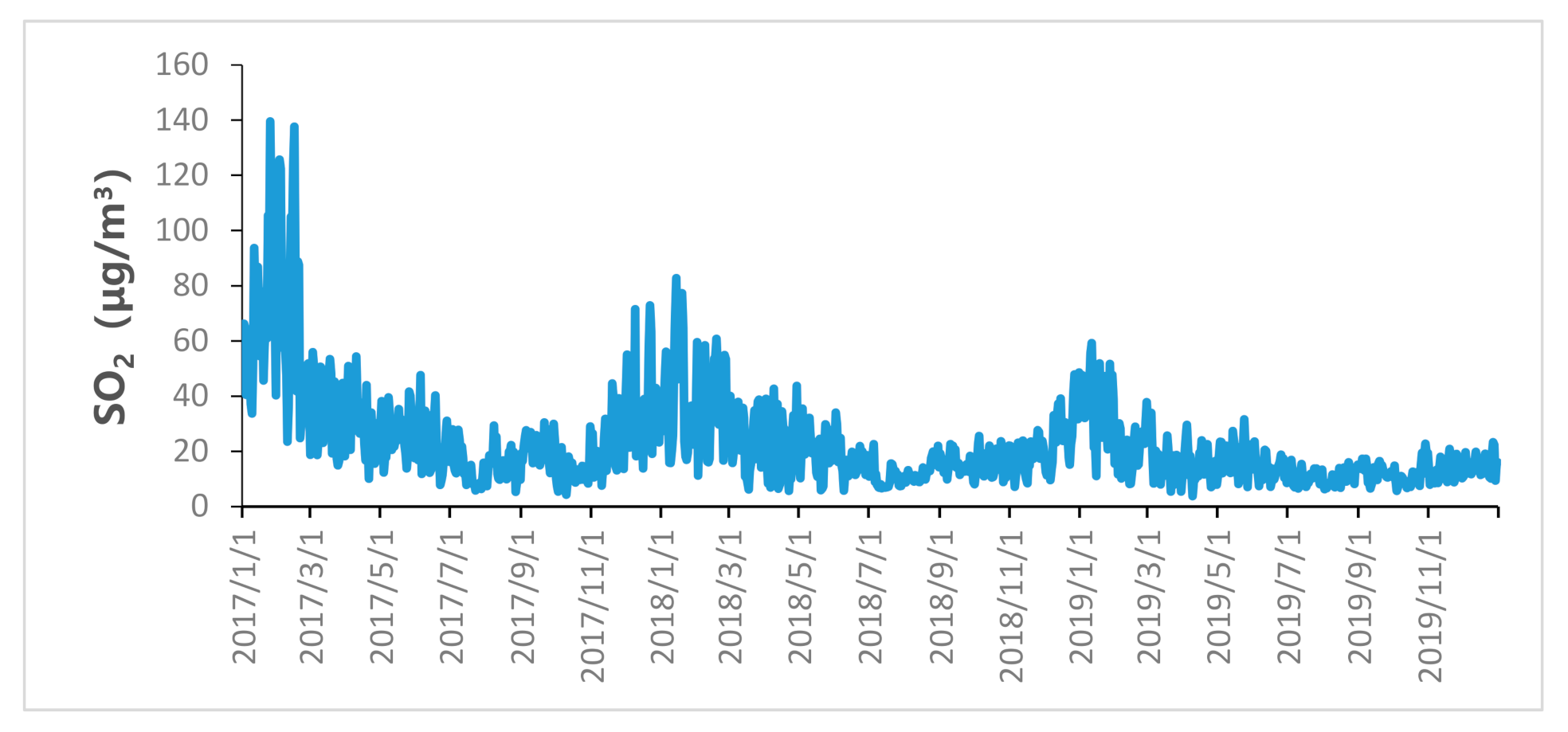
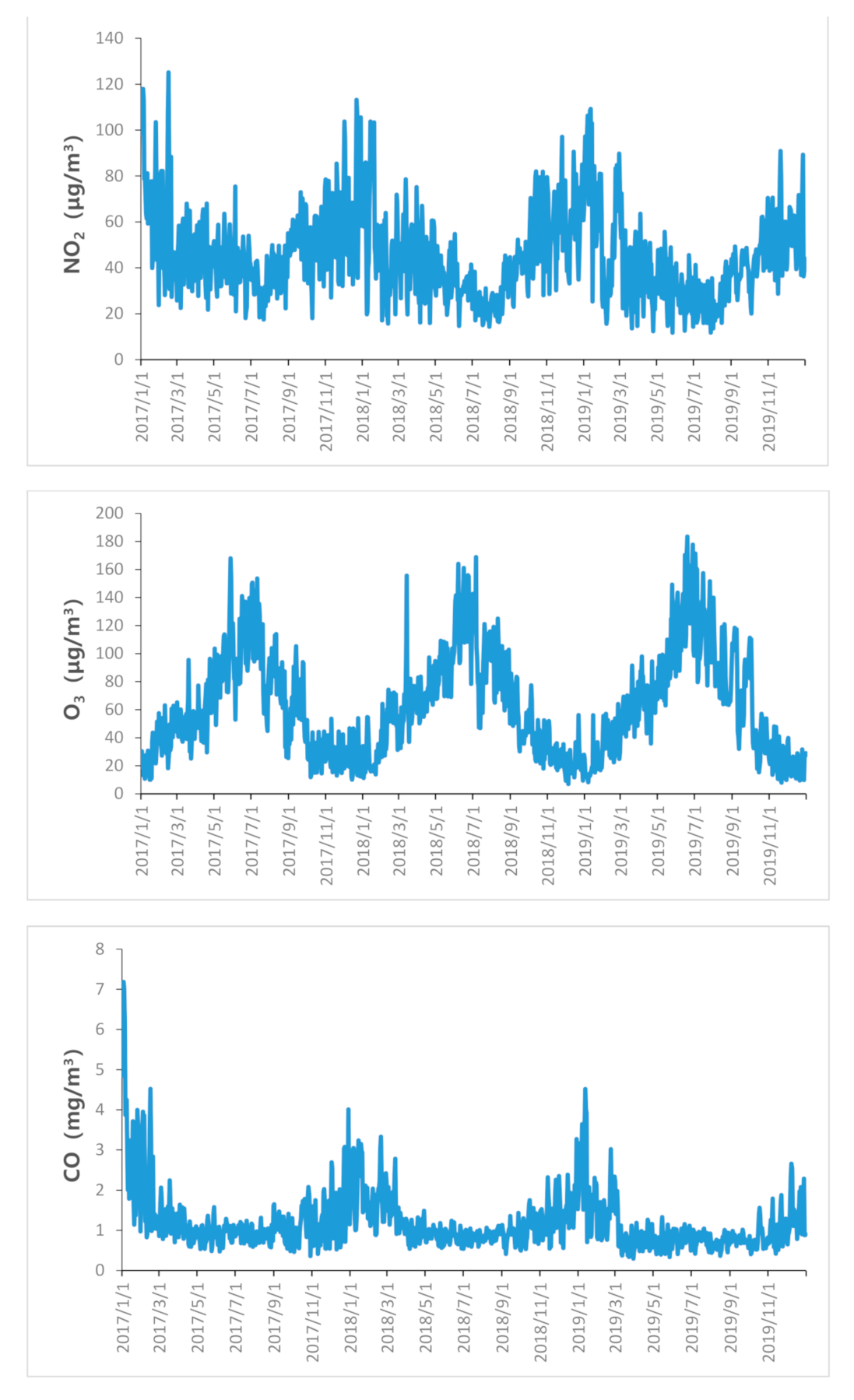
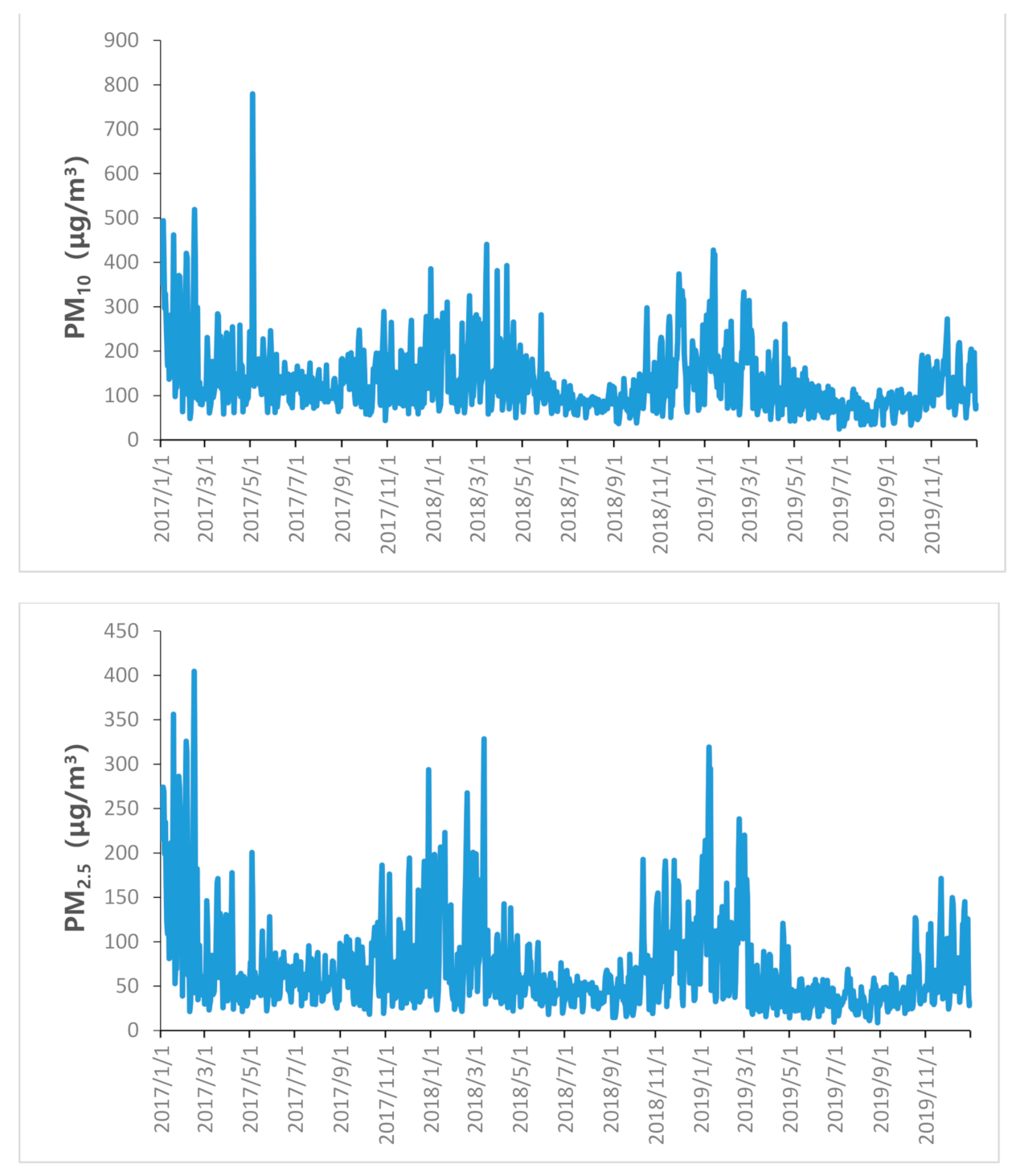


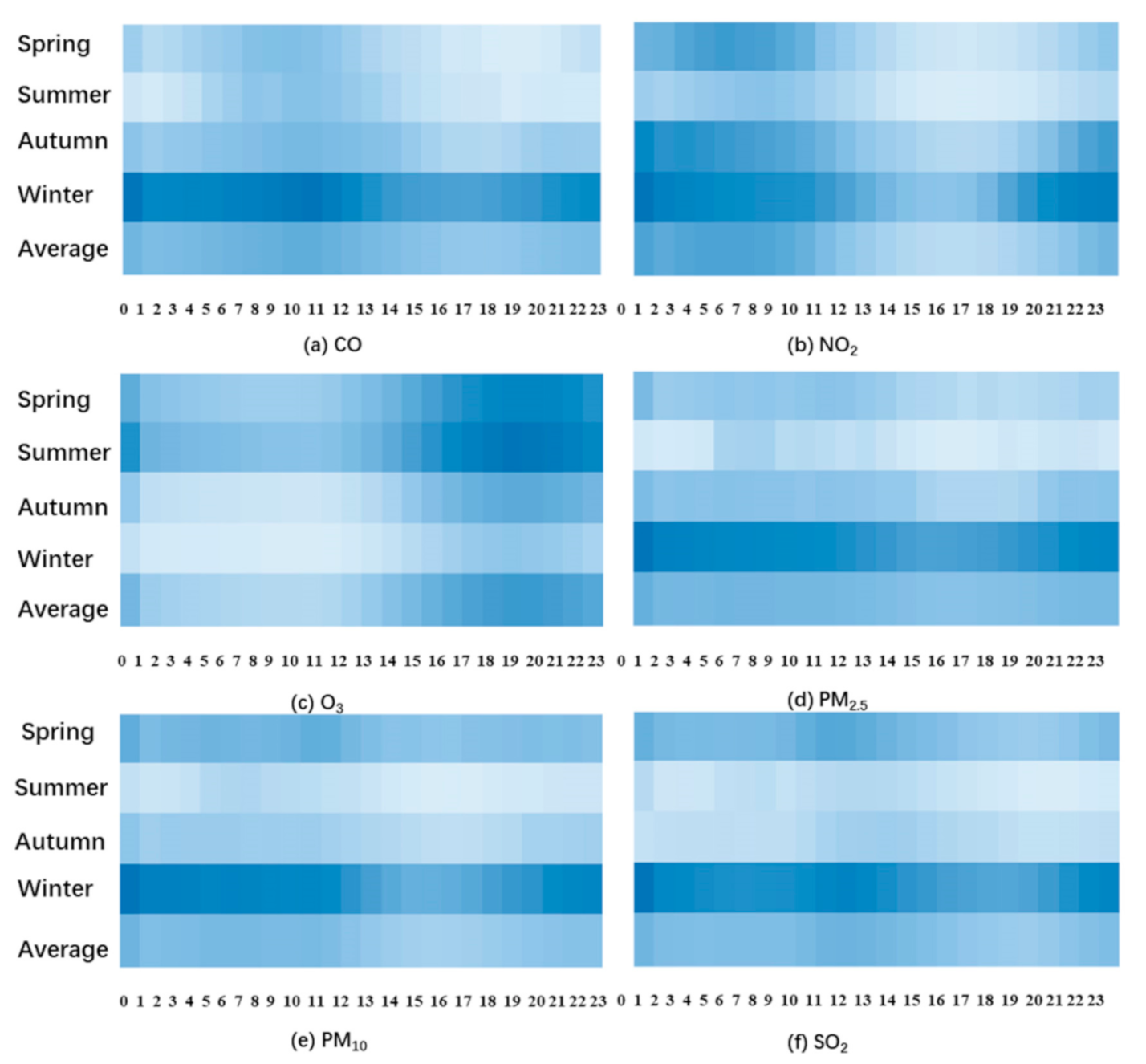
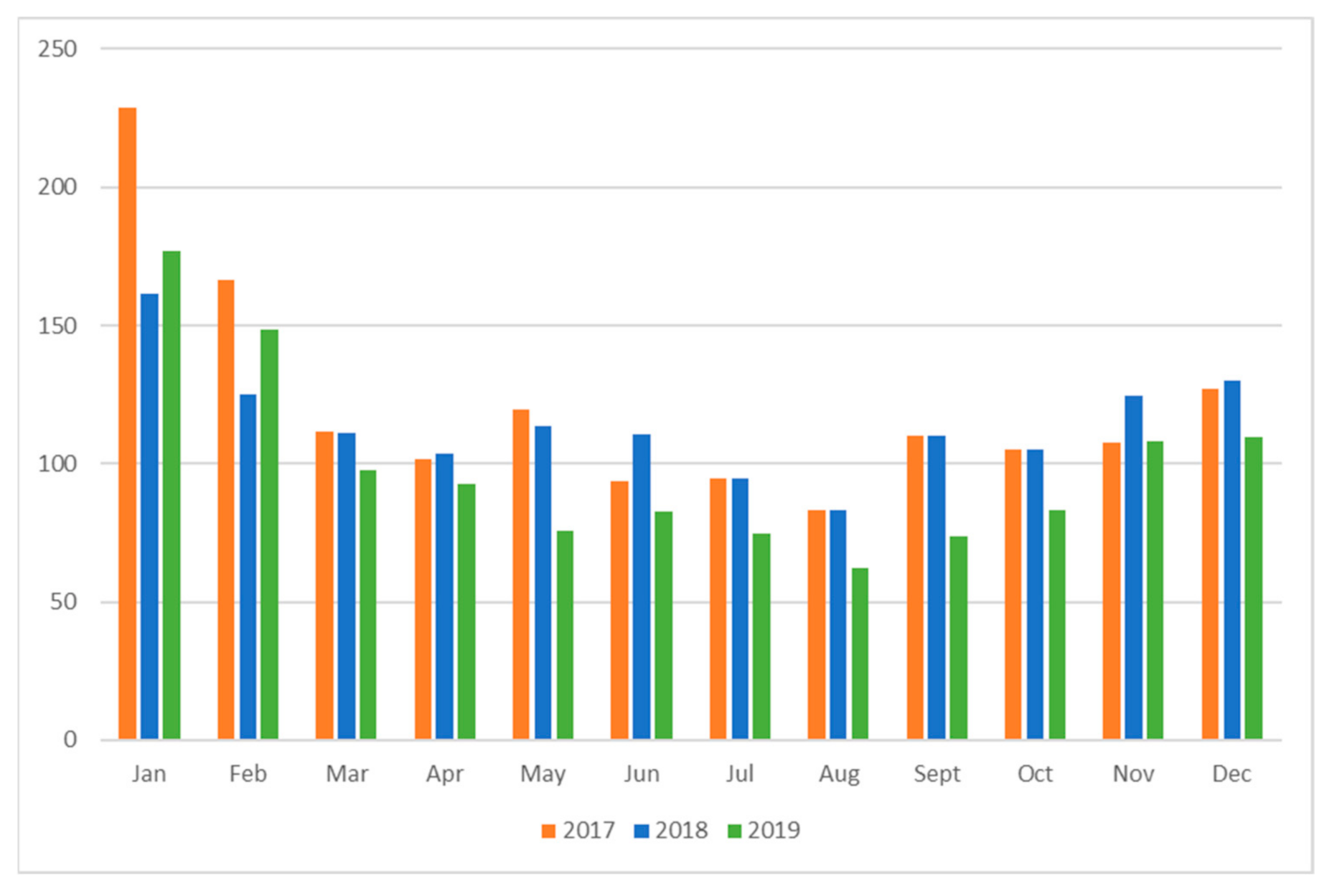
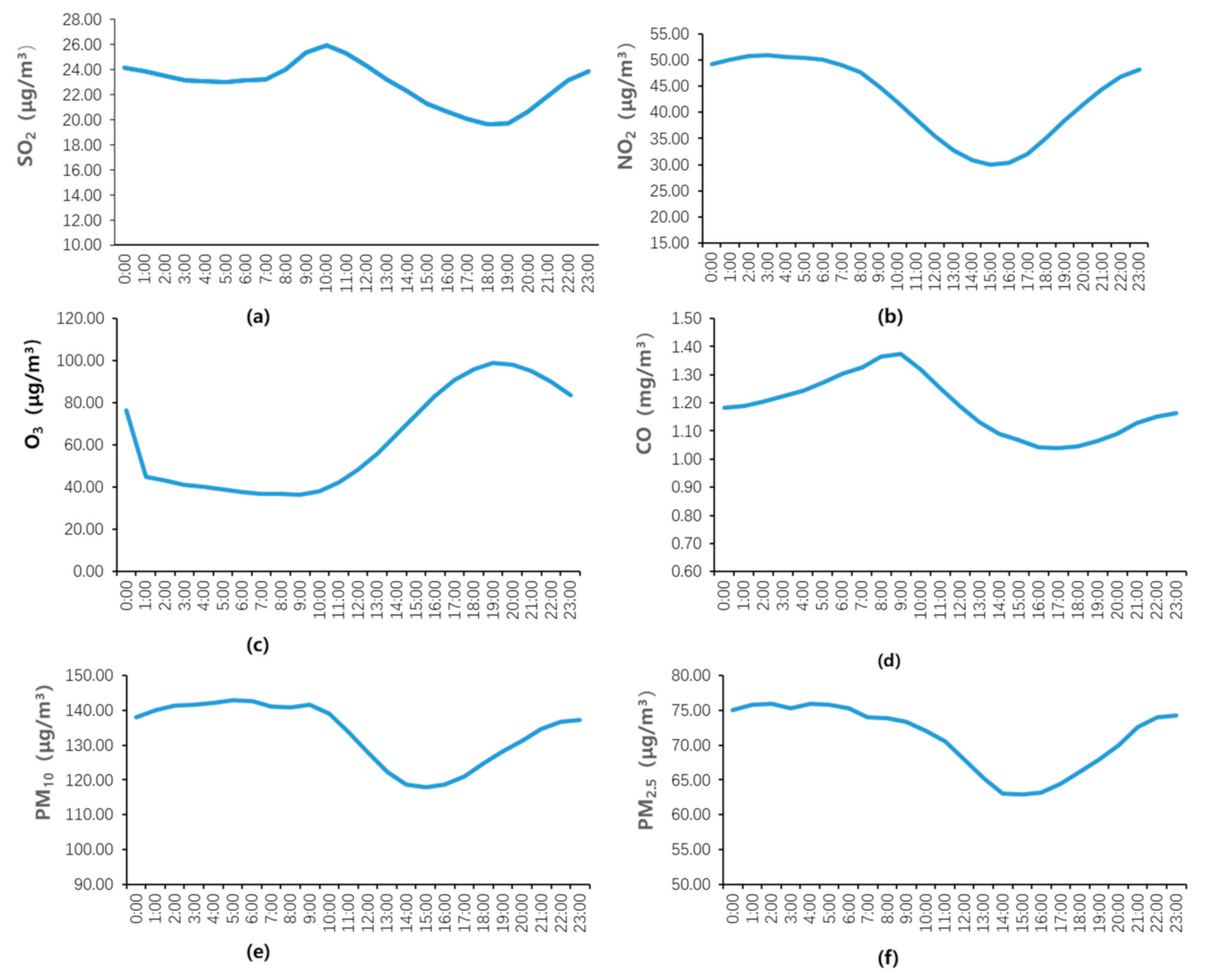
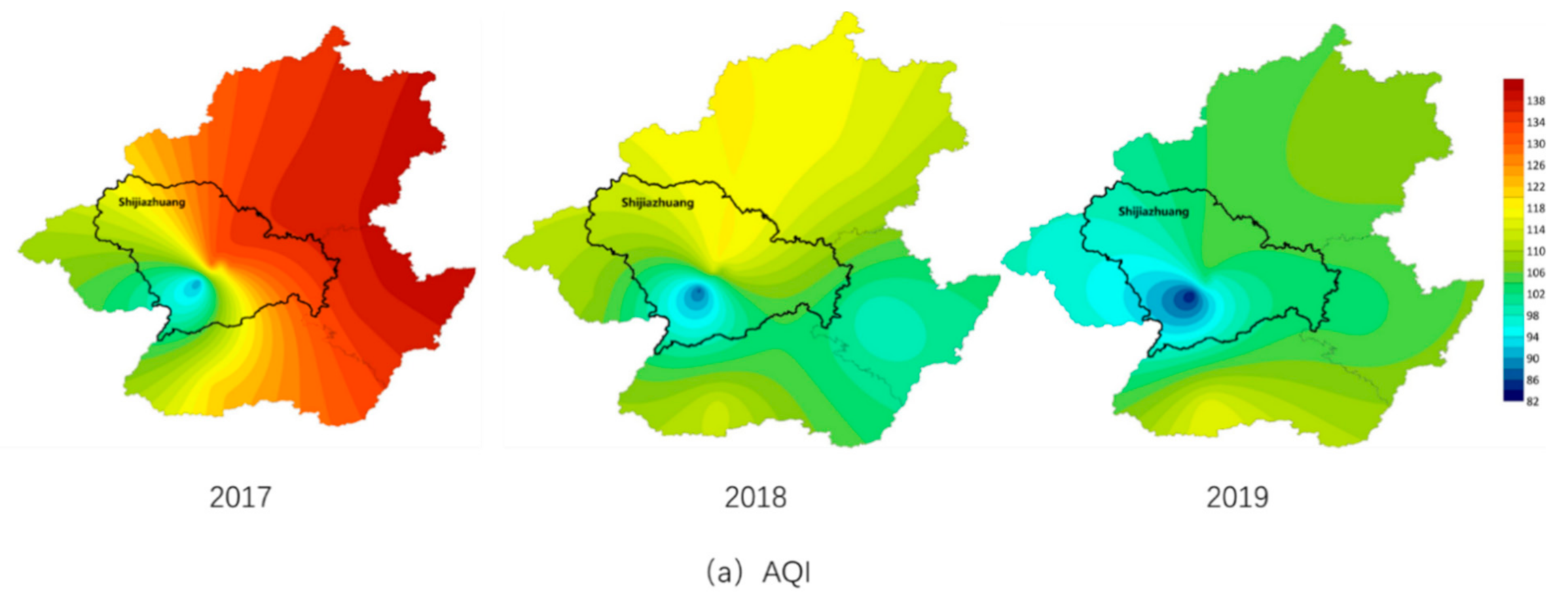



| Monitoring Station | Coordinates | Environmental Function Area |
|---|---|---|
| Staff Hospital | 114.4548° E 38.0513° N | Residential area |
| High-tech Zone | 114.6046° E 38.0398° N | Industrial area |
| Northwest Water | 114.5019° E 38.1398° N | Cultural and Educational area |
| Southwest Higher Education | 114.4586° E 38.0058° N | Cultural and Educational area |
| Century Park | 114.5331° E 38.0178° N | Commercial traffic area |
| People’s Hall | 114.5214° E 38.0524° N | Cultural and Educational area |
| Mountain Fenglong | 114.3541° E 37.9097° N | Scenic area |
| IAQI | SO2 (24-h Average, μg/m3) | SO2 (1-h Average, μg/m3) | NO2 (24-h Average, μg/m3) | NO2 (1-h Average, μg/m3) | PM10 (24-h Average, μg/m3) | CO (24-h Average, mg/m3) | CO (1-h Average, mg/m3) | O3 (1-h Average, μg/m3) | O3 (8-h Average, μg/m3) | PM2.5 (24-h Average, μg/m3) |
|---|---|---|---|---|---|---|---|---|---|---|
| 0 | 0 | 0 | 0 | 0 | 0 | 0 | 0 | 0 | 0 | 0 |
| 50 | 50 | 150 | 40 | 100 | 50 | 2 | 5 | 160 | 100 | 35 |
| 100 | 150 | 500 | 80 | 200 | 150 | 4 | 10 | 200 | 160 | 75 |
| 150 | 475 | 650 | 180 | 700 | 250 | 14 | 35 | 300 | 215 | 115 |
| 200 | 800 | 800 | 280 | 1200 | 350 | 24 | 60 | 400 | 265 | 150 |
| 300 | 1600 | / | 565 | 2340 | 420 | 36 | 90 | 800 | 800 | 250 |
| 400 | 2100 | / | 750 | 3090 | 500 | 48 | 120 | 1000 | / | 350 |
| 500 | 2620 | / | 940 | 3840 | 600 | 60 | 150 | 1200 | / | 500 |
| AQI | Air Quality |
|---|---|
| 0–50 | Excellent |
| 51–100 | Good |
| 101–150 | Light pollution |
| 151–200 | Medium pollution |
| 201–300 | Heavy pollution |
| >300 | Severe pollution |
| Number of Days with PM10 or PM2.5 as the Main Pollutant | Number of Days with O3 as the Main Pollutant | |
|---|---|---|
| 2017 | 261 | 92 |
| 2018 | 214 | 111 |
| 2019 | 193 | 131 |
Publisher’s Note: MDPI stays neutral with regard to jurisdictional claims in published maps and institutional affiliations. |
© 2021 by the authors. Licensee MDPI, Basel, Switzerland. This article is an open access article distributed under the terms and conditions of the Creative Commons Attribution (CC BY) license (http://creativecommons.org/licenses/by/4.0/).
Share and Cite
Tui, Y.; Qiu, J.; Wang, J.; Fang, C. Analysis of Spatio-Temporal Variation Characteristics of Main Air Pollutants in Shijiazhuang City. Sustainability 2021, 13, 941. https://doi.org/10.3390/su13020941
Tui Y, Qiu J, Wang J, Fang C. Analysis of Spatio-Temporal Variation Characteristics of Main Air Pollutants in Shijiazhuang City. Sustainability. 2021; 13(2):941. https://doi.org/10.3390/su13020941
Chicago/Turabian StyleTui, Yue, Jiaxin Qiu, Ju Wang, and Chunsheng Fang. 2021. "Analysis of Spatio-Temporal Variation Characteristics of Main Air Pollutants in Shijiazhuang City" Sustainability 13, no. 2: 941. https://doi.org/10.3390/su13020941




